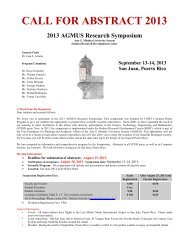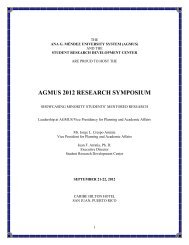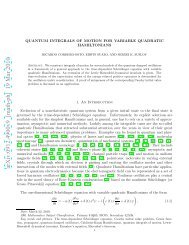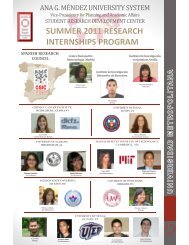WINTER 2008 PRE-COLLEGE RESEARCH SYMPOSIUM - Student ...
WINTER 2008 PRE-COLLEGE RESEARCH SYMPOSIUM - Student ...
WINTER 2008 PRE-COLLEGE RESEARCH SYMPOSIUM - Student ...
Create successful ePaper yourself
Turn your PDF publications into a flip-book with our unique Google optimized e-Paper software.
COMPUTATIONAL STUDY OF ACETONE-(CH 3 ) 2 CO-FOUND IN SAGITTARIUS B2<br />
Gabriel Díaz, Bautista de Puerto Nuevo Academy, San Juan, Puerto Rico.<br />
Research Mentors: Dr. Juan F. Arratia, Executive Director, <strong>Student</strong> Research Development<br />
Center, Ana G. Méndez University System, San Juan, Puerto Rico; Dr. José Cernicharo,<br />
Department of Astrophysics, Astrobiology Center, Spanish Research Council (CSIC), Madrid,<br />
Spain.<br />
<strong>Student</strong> Research Mentor: Germán P. Castillo, Universidad Metropolitana, San Juan, Puerto<br />
Rico.<br />
The purpose of this study was to learn about the molecule Acetone (CH 3 ) 2 CO in space and to<br />
develop a computational model. This molecule was found in Sagittarius B2 by F. Combes, M.<br />
Gerin, A. Wooten, among others. Sagittarius B2 is a massive, dense HII region and molecular<br />
cloud complex located near the center of our Galaxy. In the dense region of the molecular cloud<br />
the temperature is 300 Kelvin (27 C). This region is the richest concentration of molecules of our<br />
galaxy. Acetone is a colorless, mobile, flammable liquid. Acetone is highly miscible and also<br />
serves as an important solvent. The molecule of acetone was made into a 3-D model using the<br />
software GaussView and was used for computational chemistry calculations to find the most<br />
stable state and its energy using Gaussian 03. The parameters for these calculations are the<br />
difference in temperature and pressure between Earth and Sagittarius B-2. The investigation<br />
established a relationship between temperature and the energies. The zero point energy remains<br />
constant unaffected by temperature or pressure. The enthalpy and energy showed an inversely<br />
proportional behavior to temperature, and Gibbs free energy behaved directly proportional to<br />
temperature. During this investigation basic chemistry concepts were provided and it was<br />
possible to understand how to correctly model a molecule based on its formula.<br />
COMPUTATIONAL STUDY OF FORMIC ACID–HCOOH FOUND IN SAGITTARIUS<br />
B2<br />
Jonathan Irizarry, Bautista De Puerto Nuevo Academy, San Juan, Puerto Rico.<br />
Research Mentors: Dr. Juan F. Arratia, Executive Director, <strong>Student</strong> Research Development<br />
Center, Ana G. Méndez University System, San Juan, Puerto Rico; Dr. José Cernicharo,<br />
Department of Astrophysics, Astrobiology Center, Spanish Research Council (CSIC), Madrid,<br />
Spain.<br />
<strong>Student</strong> Research Mentor: Germán P. Castillo, Universidad Metropolitana San Juan, Puerto Rico.<br />
Formic acid (HCOOH or CH 2 O 2 ) is a hot core molecule, first detected in the Sagittarius B2 cloud<br />
by B. Zuckerman. The Sagittarius B2 is a dense molecular cloud complex and the biggest<br />
concentration of molecules in our Galaxy. In this region the temperature has been recorded to be<br />
300 Kelvin (27°C). The number of observed isotopic transitions in the detection of Formic Acid<br />
is too small for it to be conclusive. One of the objectives of the project was to discover how the<br />
molecule behaves in space. Additionally, the Gaussian 03 and the GaussView software were<br />
used. These programs allowed for the creation of a 3-D model of the molecule. When using the<br />
3D version of the molecule, computational chemistry calculations were performed in order to find<br />
its most stable state and its energies. From the investigation, a relationship was established<br />
between temperature and the energies. The zero point energy remained constant unaffected by<br />
temperature or pressure. The enthalpy and energy showed an inversely proportional behavior to<br />
temperature, and Gibbs free energy behaved directly proportional to temperature. During this<br />
investigation basic chemistry concepts were provided and it was possible to understand how to<br />
correctly model a molecule based on its formula.<br />
28








